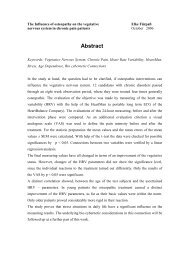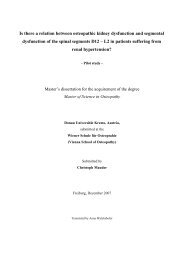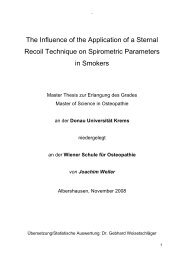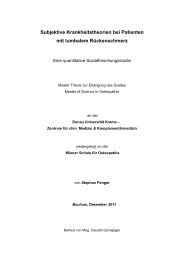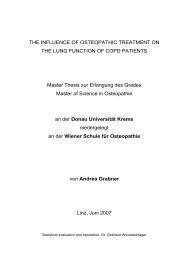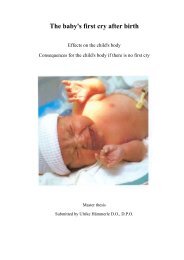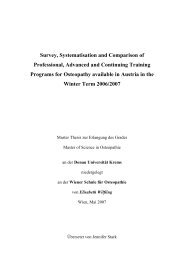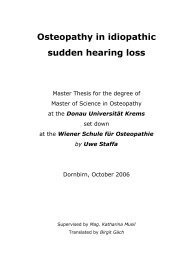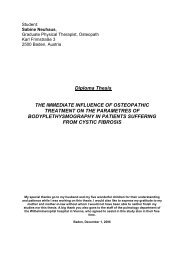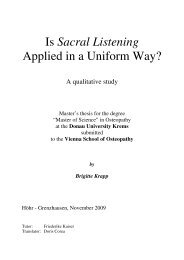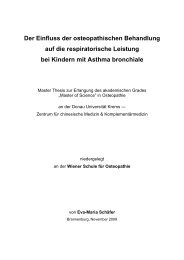Can back pain caused by symptom-giving sacroiliac joint relaxation ...
Can back pain caused by symptom-giving sacroiliac joint relaxation ...
Can back pain caused by symptom-giving sacroiliac joint relaxation ...
Create successful ePaper yourself
Turn your PDF publications into a flip-book with our unique Google optimized e-Paper software.
0. Introduction<br />
<strong>Can</strong> osteopathic treatment reduce <strong>back</strong> <strong>pain</strong> in pregnancy <strong>caused</strong> <strong>by</strong> <strong>sacroiliac</strong> <strong>joint</strong><br />
<strong>relaxation</strong>? This Master’s thesis will try to answer this question.<br />
In my daily work as an osteopath I have recognised my personal interest in the most<br />
diverse possibilities to treat women osteopathically during their pregnancy. Frequent<br />
positive feed<strong>back</strong> after having treated pregnant women was a motivation for me to<br />
investigate in this field. In fact it was during my wife's pregnancy, who gave birth to<br />
our daughter Iris in spring 2006, that the idea for this empirical study came to my<br />
mind.<br />
In their article published in 2000 [9] DiGiovanna and Schiowitz describe the role of<br />
osteopathy during pregnancy very concisely: Osteopathic care throughout pregnancy<br />
provides the woman with the special benefits of adjusting the functions of her body to<br />
the demands of the progressing pregnancy. [9, p. 459] When treating pregnant<br />
women it is, time and again, a great challenge to adapt one's therapeutic techniques<br />
to the changes and developments taking place during pregnancy. There are studies<br />
[22, 23, 64] which show that osteopathic manual treatment (OMT) influences the birth<br />
process in a positive way, but there are hardly any studies [25] which account for a<br />
positive influence on mothers' health during pregnancy.<br />
My study intends to show that OMT can considerably reduce <strong>back</strong> <strong>pain</strong> <strong>caused</strong> <strong>by</strong><br />
SIJ <strong>relaxation</strong> which appears physiologically during pregnancy. As SIJ stability<br />
depends on various biomechanical factors [24], it seems obvious to me that great<br />
positive effects can be achieved <strong>by</strong> the application of OMT.<br />
The hypothesis of my study reads as follows: After having treated a pregnant woman<br />
suffering from <strong>back</strong> <strong>pain</strong> due to <strong>sacroiliac</strong> <strong>joint</strong> <strong>relaxation</strong> three times with OMT, it is<br />
possible to demonstrate, <strong>by</strong> means of the two parameters <strong>pain</strong> intensity and quality<br />
of life, that the discomfort of a pregnant woman is clearly reduced in a given period of<br />
time after OMT compared to the discomfort in a given period of time before<br />
therapeutic intervention. For this purpose I used a study design of repeated<br />
measurements with non-randomised samples.<br />
As the period of pregnancy is a very delicate time which is sometimes accompanied<br />
<strong>by</strong> diverse complications [13, 38], it is an interesting challenge for osteopathy to<br />
adapt OMT to the needs of pregnant women in a way that significant improvements<br />
Master’s Thesis Wolfgang Aspalter 9



